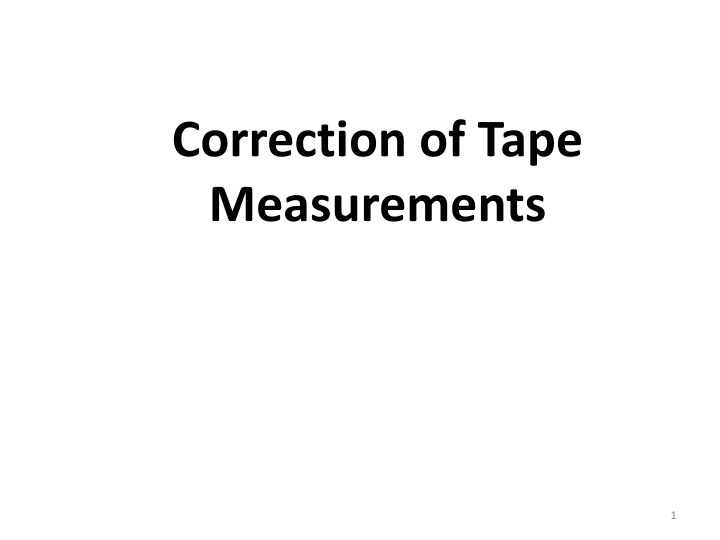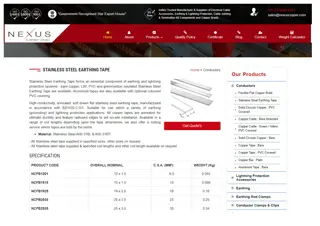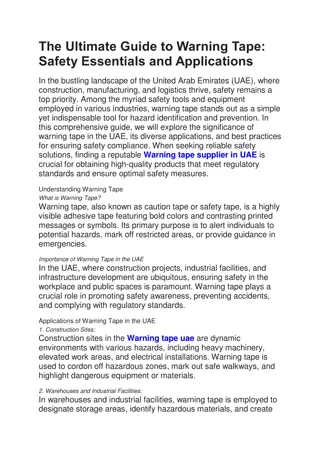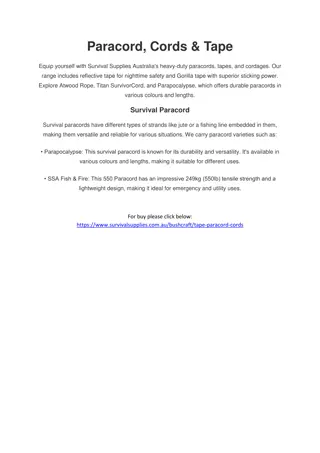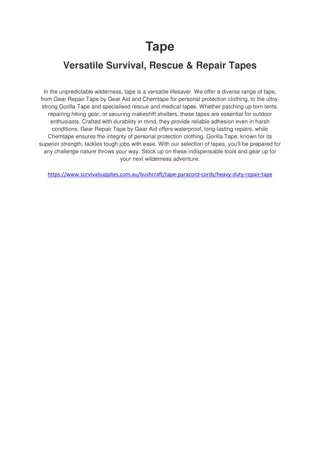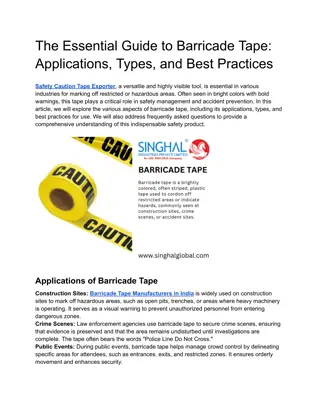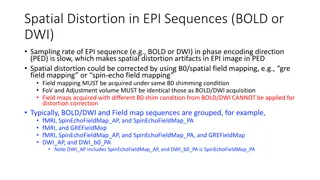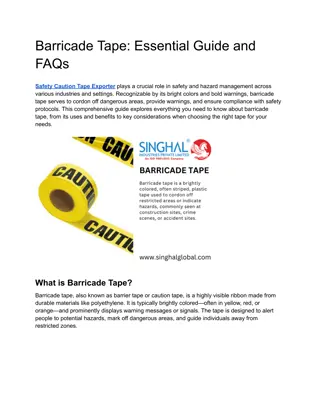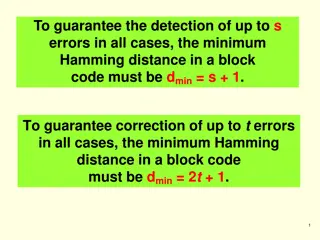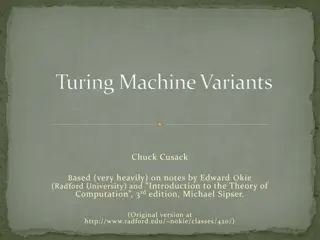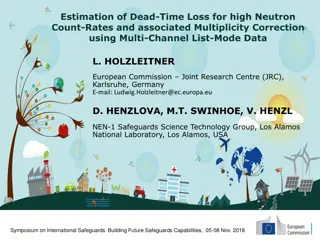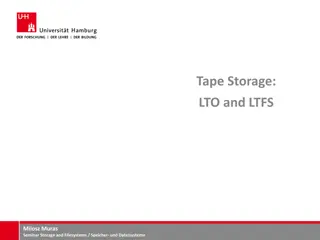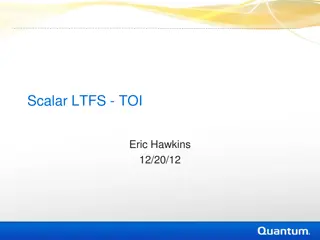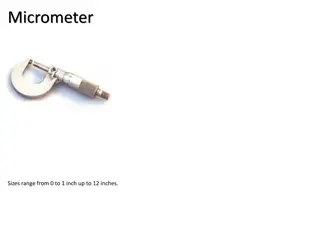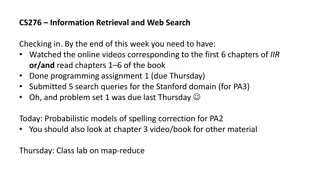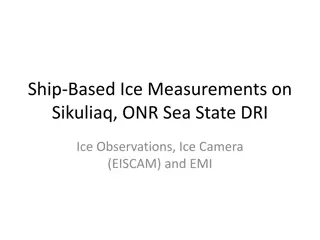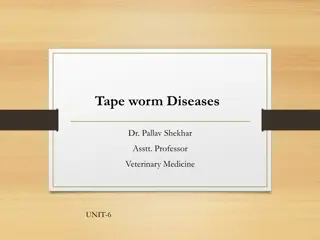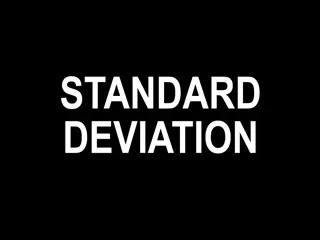Correction of Tape Measurements - Standard Conditions and Operations
This content discusses the correction of tape measurements under standard conditions, including systematic and random errors, applying corrections, taping operations, and slope correction examples. It covers topics such as measuring between points, slope expressed as a gradient, and calculating horizontal distances based on slope distances and angles. Learn how to correct errors in tape measurements effectively with practical examples.
Download Presentation

Please find below an Image/Link to download the presentation.
The content on the website is provided AS IS for your information and personal use only. It may not be sold, licensed, or shared on other websites without obtaining consent from the author.If you encounter any issues during the download, it is possible that the publisher has removed the file from their server.
You are allowed to download the files provided on this website for personal or commercial use, subject to the condition that they are used lawfully. All files are the property of their respective owners.
The content on the website is provided AS IS for your information and personal use only. It may not be sold, licensed, or shared on other websites without obtaining consent from the author.
E N D
Presentation Transcript
Correction of Tape Measurements 1
STANDARD CONDITIONS Foot system Temperature - 68 F Tape fully supported Tension 10 lbs Tension 50 N (Newtons) 1 lb = 4.448 N ERRORS IN TAPING Systematic taping errors Slope Erroneous length Temperature Tension Sag Marking Plumbing Straightness of tape Observational imperfections Metric system Temperature 20 C Tape fully supported Random taping errors Slope Temperature Tension Sag Alignment 2
APPLYING CORRECTIONS T=R+ C or T =R- E where T = True Value R = Field Reading C = Correction E = Error 3
TAPING OPERATIONS Measuring between points The value R is recorded in the field and the corrections computed T is calculated Setting out a value T is now known and the corrections are computed R is calculated to the conditions in the field SLOPE CORRECTION From right triangle geometry H: horizontal distance S: slope distance V: vertical distance : vertical angle Z: zenith angle 4
SLOPE CORRECTION Slope expressed as gradient or rate of grade Ratio of vertical distance over horizontal distance Rise over run A +2% slope means 2 units rise in 100 units horizontal A -3.5% slope means 3.5 units fall in 100 units horizontal Elev.564,22 -2.5% 0+00 Elev.=? 1+50 5
476.77 471.37 4+37.25 1+00 6
SLOPE CORRECTION EXAMPLE The slope distance between two points is 78.22 and the vertical angle is 1 20 . What is the corresponding horizontal distance? Horizontal distance: 1 2 78.22 ft The slope distance between two points is 78.22 and the zenith angle is 88 40 . What is the corresponding horizontal distance? 7
SLOPE CORRECTION EXAMPLE A slope rises from one point, a distance of 156.777m, to another point at a rate of +1.5%. What is the corresponding horizontal distance between the points? 156.777m B +1.5% A 8
The slope distance between two points is measured to be 199.908 m and the vertical distance between the points (i.e., the difference in elevation) is +2.435 m. What is the horizontal distance between the points? Horizontal distance: 9
SLOPE CORRECTION So far compute H and V directly Can compute correction Error due to slope: Correction for slope: Substitute Correction for slope: 10
If vertical distance given instead of vertical angle Correction: Use binomial theorem and expand radical Reducing Generally, only first term used Valid for slope < 10-15% Where required precision < 1:15,000 If more precision necessary, additionalterms required 11
SLOPE CORRECTION (ALTERNATIVE) Height from Pythagorean Theorem If slope not too large, slope and horizontal distances nearly the same 12
SLOPE CORRECTION EXAMPLE A measurement was made along a line inclined by 3 22 . The slope distance is 3,236.86 . What is the horizontal distance? Correction for slope horizontal distance If the uncertainty in was 1 , what is the uncertainty in the entire length? Uncertainty: Corrected distance: 15
STANDARD LENGTH CORRECTION Tapes assumed to be correct as manufactured Exception is for precise taping Wear tapes become kinked and stretched Correction: S = calibrated value of tape Discrepancy found through tape comparison to a standard tape Estimate of error in calibration: e Uncertainty in length of line due to error in calibration: n = number of tape lengths Error tends not to compensate 16
STANDARD LENGTH EXAMPLE A measurement was recorded as 171.278 m with a 30-m tape that was only 29.996 m under standard conditions. What is the corrected measurement? Correction per tape length: Number of tape lengths: Total correction: Corrected distance: 17
STANDARD LENGTH EXAMPLE If the uncertainty in the calibrated length of the line is 0.0012 m, what is the uncertainty in the entire length of the line? Total uncertainty is: The length of the line is then STANDARD LENGTH EXAMPLE: A surveyor is using a tape whose standard length is 100.02 .Two pins need to be set out 600.00 apart. What is the field measurement needed to set out the correct length? Correction per tape length Total correction Field reading 18
TEMPERATURE Tape susceptible to dimensional change due to variation in temperature Correction: CT = correction due to temperature = length of tape = coefficient of thermal expansion = 0.00000645 per 1 F = 0.0000116 per 1 C T = field temperature TS = standard temperature (Normally 68 F or 20 C) 19
Uncertainty differentiate w.r.t. T From error propagation, error in one tape length due to error in temp is: 20
TEMPERATURE UNCERTAINTY Last formula assumes uncertainty same for each length Generally average temp. used over line Thus, error would not tend to compensate Total error estimate: Recognizing L = n, TEMPERATURE CORRECTION EXAMPLE You must lay out two points in the field that will be exactly 100.000 m apart. Field conditions indicate that the temperature of the tape is 27 C. What distance will be laid out? Correction for temperature: Distance used to lay out: 21
TEMPERATURE CORRECTION EXAMPLE: Line is measured as 876.42 m. The field temperature is 24 C.A 30-m tape with correct length at 20 C was used. Find the corrected length of the line. The correction per tape length: If eT = 1 C, the total error estimate is The distance is: 876.46m 0.01m 22
TENSION CORRECTION Applied stress of wire force per unit area Resultant strain elongation per unit length where: P = tension (force) A = cross-sectional area of tape eL = elongation produced by tension = length of tape Hooke s Law: P proportional to eL and stress proportion to strain Insert constant: Proportionality constant (E) called Young s modulus of elasticity 23
TENSION CORRECTION Error found by comparing elongation produced from standardized tension (PS) and field tension (P) Correction: Young s modulus of elasticity normally between 28,000,000 psi to 30,000,000 psi Uncertainty only variable: field tension where: eP = error in one tape length eP = error in determining tension Error for total length of line (error propagation) 24
TENSION CORRECTION EXAMPLE Given: A = 0.0040 sq. in, P = 25 lbs,E = 29,000,000 psi, PS = 15 lbs,L = 1,000.00 Correction for tension: Corrected distance: If the uncertainty in P is 1-lb, what is the uncertainty due to tension? Uncertainty per tape length: Total uncertainty: Distance = 1,000.09 0.003 25
TENSION CORRECTION Cross-sectional area Measured with micrometer Taken from manufacturer s specifications Computed from: 26
SAG CORRECTION Tape supported at ends will sag in center Amount of sag depends on Weight of tape per unit length Applied tension Arc forms centenary curve or approx. parabola. 27
SAG CORRECTION F is force and the components are shown here can distinguish between forces in x and y directions Differentiation of equation of parabola gives slope at support B Tape forms differentially short segments of curve ds found by differentiation Integrate to find total length of curve Horizontal force will approach tension and horizontal distance approaches the curve 28
SAG CORRECTION Correction for sag given as: Also expressed in terms of weight per foot Sag correction always negative Sag varies with tension Uncertainty take derivative of correction equation w.r.t. P and use general propagation formula Assuming came conditions for all tape lengths, error due to sag for total length: 29
SAG CORRECTION EXAMPLE A 100 steel tape weights 0.02 lbs/ft and supported at the ends only with a tension of 12 lbs. A distance of 350.00 was measured. What is the correction for sag? Correction per tape length (100 ) is: Correction for 50 section is Total correction: 30
SAG CORRECTION EXAMPLE If the uncertainty in tension was 1 lb., what is the uncertainty in the total length? For 3 full tape lengths For 50 tape length For full length: Distance: 31
NORMAL TENSION Use tape correction to negate effects of sag in tape Make error in sag = correction for tension Define normal tension P Pn Note that normal tension (Pn) on both sides of equation Use as a first approximation Then take this value for Pn into the previous equation and solve for new normal tension Continue until difference below criteria 32
NORMAL TENSION EXAMPLE: Find the normal tension given: A = 0.0040 sq. in. W = 1.3 lbs E = 29,000,000 psi PS = 15 lbs Initial estimate of normal tension Adjusted value for normal tension Use mean value of the last 2 Pn values: 27 lbs 33
INCORRECT ALIGNMENT May occur when more than one tape length measured in field Error: random in nature systematic in effect Lateral displacement from true line causes systematic error Correction for alignment for entire length found by =lateraldisplacement =alignment error 34
TAPE NOT STRAIGHT Taping in brush and when wind blowing Impossible to have all parts in perfect alignment Error systematic & variable Same as measuring with tape that is too short Amount of error Less if bend in in center Increases as it gets closer to ends Reduced by careful field procedures IMPERFECTIONS IN OBSERVATIONS Personal errors or blunders Plumbing Marking tape ends with tape fully supported Adding or dropping full tape length Adding a foot or decimeter Other points incorrectly taken as end mark on tape Reading numbers incorrectly Calling numbers incorrectly or not clearly 35
